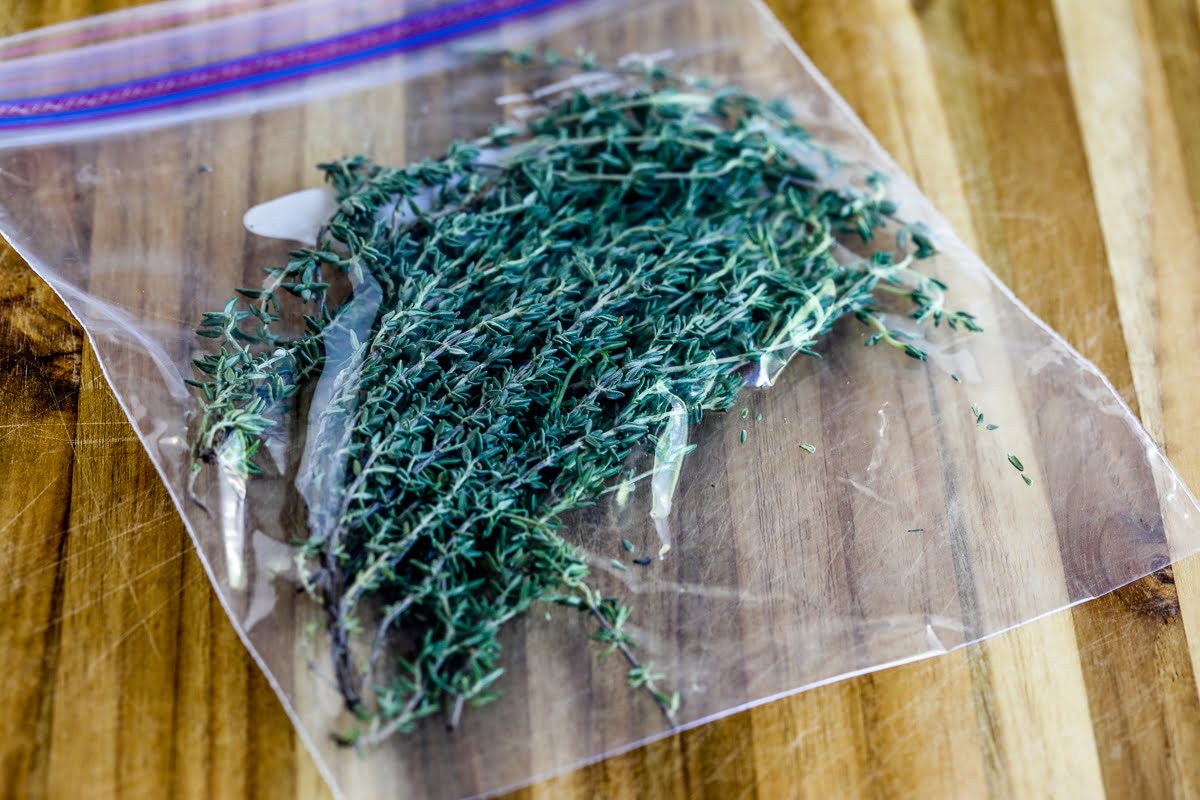

Articles
How To Store Rosemary Water For Hair
Modified: August 17, 2024
Discover the best method for storing rosemary water to nourish and strengthen your hair. Our articles provide step-by-step instructions and tips for maximizing the benefits of this natural remedy.
(Many of the links in this article redirect to a specific reviewed product. Your purchase of these products through affiliate links helps to generate commission for Storables.com, at no extra cost. Learn more)
Introduction
Rosemary is a fragrant and versatile herb that has been used for centuries for its culinary and medicinal properties. Not only does it add a delightful flavor to dishes, but it also has numerous benefits for hair health. One popular way to harness the goodness of rosemary for hair is by making rosemary water.
Rosemary water is a natural and soothing hair care solution that can help promote hair growth, strengthen the hair follicles, reduce dandruff, and add shine to your locks. It is easy to make at home and can be stored for future use, allowing you to enjoy its benefits on a regular basis.
In this article, we will explore the benefits of rosemary water for hair, how to make it, and the best methods for storing it. Whether you’re dealing with hair problems like hair loss or just want to improve the overall health and appearance of your hair, rosemary water can be a game-changer in your hair care routine.
Key Takeaways:
- Rosemary water is a versatile elixir for hair, offering benefits such as promoting growth, reducing dandruff, and adding shine. Making and storing it properly ensures long-lasting hair health benefits.
- Properly stored rosemary water can be used for up to a month, offering a natural and nourishing addition to your hair care routine. Dilute, massage, and experiment with other ingredients for optimal results.
Read more: How To Store Rosemary
Benefits of Rosemary Water for Hair
Rosemary water is a powerhouse of nutrients and antioxidants that can provide a range of benefits for your hair. Let’s take a closer look at some of the key advantages:
- Promotes Hair Growth: Rosemary water contains compounds that stimulate blood circulation in the scalp, which can promote hair growth. It also helps to strengthen the hair follicles and prevent hair loss.
- Reduces Dandruff: The antifungal properties of rosemary water can help combat dandruff and relieve an itchy scalp. Regular use can reduce flakiness and improve the overall health of your scalp.
- Prevents Premature Graying: Rosemary water is rich in antioxidants that help neutralize free radicals and prevent oxidative stress. This can slow down the graying process and maintain the natural color of your hair.
- Adds Shine and Luster: The natural oils present in rosemary water can nourish and moisturize the hair, leaving it shiny and lustrous. It also helps to smooth down the cuticles, reducing frizz and improving the overall appearance of your locks.
- Strengthens Hair: Regular use of rosemary water can strengthen the hair shaft, making it less prone to breakage and damage. This can result in thicker, healthier, and more resilient hair.
- Soothes the Scalp: The soothing properties of rosemary water can calm irritation and inflammation on the scalp. It can help alleviate conditions like scalp acne, itching, and dryness, leaving your scalp feeling refreshed and comfortable.
These are just a few of the amazing benefits that rosemary water can offer for your hair. Incorporating it into your hair care routine can not only improve the health of your hair but also enhance its appearance and manageability. Let’s now delve into how you can make rosemary water at home.
How to Make Rosemary Water
Making your own rosemary water at home is a simple and straightforward process. There are a couple of methods you can choose from, depending on your preference and the time you have available. Here are the steps to make rosemary water:
Preparing the Rosemary
First, you need to gather a fresh bunch of rosemary. If you have access to a rosemary plant, you can harvest a few sprigs. Alternatively, you can purchase fresh rosemary from a grocery store or market. Make sure to choose organic rosemary for the best results, as it is free from chemicals and pesticides.
Method 1: Boiling Method
- Start by removing the rosemary leaves from the sprigs. You can do this by holding the top end of the sprig and running your fingers along the stem to remove the leaves.
- Fill a pot with clean water and bring it to a boil.
- Add the rosemary leaves to the boiling water and let it simmer for about 15-20 minutes.
- Turn off the heat and allow the rosemary water to cool down.
- Strain the cooled mixture using a sieve or cheesecloth into a clean container.
- Your rosemary water is now ready to use or store.
Read more: How To Store Clove Water For Hair
Method 2: Infusion Method
- Remove the rosemary leaves from the sprigs as explained in the previous method.
- Place the rosemary leaves in a clean jar or bottle.
- Fill the jar or bottle with filtered water, making sure that all the rosemary leaves are fully submerged.
- Tightly close the lid and let the mixture sit for at least 24 hours to allow for infusion.
- After 24 hours, strain the liquid using a sieve or cheesecloth into another container.
- Your homemade rosemary water is now ready to use or store.
You can choose the method that suits you best based on the ingredients and equipment you have available. Both methods are effective in extracting the beneficial properties of rosemary into the water.
Preparing the Rosemary
Before you begin the process of making rosemary water, it’s important to properly prepare the rosemary sprigs. Here are some steps to follow:
- Start by selecting fresh rosemary sprigs. Look for ones that are vibrant green and aromatic. Avoid using wilted or discolored sprigs, as they may not provide optimal results.
- Gently rinse the rosemary sprigs under cool water to remove any dirt or debris. Pat them dry with a clean towel or paper towel.
- Once the sprigs are dry, hold each sprig at the top end and run your fingers along the stem in the opposite direction of the leaves. This will help detach the leaves from the stem.
- Continue removing the leaves from all the rosemary sprigs, and discard the stems. You should be left with a pile of fresh rosemary leaves.
- Take a moment to appreciate the invigorating aroma of the rosemary leaves. The scent alone can provide a refreshing experience.
At this stage, your rosemary leaves are ready to be used in the methods described earlier to make rosemary water. Whether you choose the boiling method or the infusion method, having properly prepared rosemary leaves ensures optimal extraction of the herb’s beneficial properties.
Remember, it’s always best to use freshly harvested or recently purchased rosemary for the highest potency. If you have an herb garden, consider growing your own rosemary so that you have a readily available supply whenever you need it. Organic rosemary is particularly recommended to avoid any potential exposure to pesticides or chemicals.
Now that the rosemary is prepared, you can proceed with making rosemary water using your preferred method. Let’s explore the steps for each method in detail.
Method 1: Boiling Method
The boiling method is a quick and straightforward way to make rosemary water. Follow these steps to create your own rosemary water using the boiling method:
- Start by gathering your prepared rosemary leaves. Ensure that you have enough leaves to create a concentrated rosemary infusion.
- Fill a pot with clean water and place it on the stove over medium heat. The amount of water you use will depend on how much rosemary water you want to make.
- Once the water comes to a boil, add the rosemary leaves to the pot. Stir the water gently to ensure that the leaves are evenly distributed.
- Reduce the heat to low and let the rosemary leaves simmer in the water for approximately 15-20 minutes. The simmering process allows the water to extract the beneficial compounds from the rosemary leaves.
- After the allotted time, remove the pot from the heat and let the rosemary water cool down to room temperature. This cooling process ensures that all the goodness from the rosemary is infused into the water.
- Once the rosemary water has cooled, strain it using a sieve or a cheesecloth into a clean container. This step will remove any solid debris, leaving you with clear rosemary water.
Your homemade rosemary water is now ready to be used or stored. You can transfer it to a spray bottle for easy application or pour it into a jar or bottle for future use.
Note that the boiling method provides a more concentrated rosemary water, which can be diluted with water before use if desired. This method is ideal if you want a strong infusion of rosemary to fully benefit from its properties.
Now that you know how to make rosemary water using the boiling method, let’s explore an alternative method known as the infusion method.
Method 2: Infusion Method
The infusion method is an alternative way to make rosemary water that involves steeping the rosemary leaves in water to extract their beneficial properties. Follow these steps to make rosemary water using the infusion method:
- Start by gathering your prepared rosemary leaves. Make sure you have enough leaves to create a potent rosemary infusion.
- Take a clean jar or bottle and place the rosemary leaves inside it. The amount of rosemary leaves you use will depend on the size of your container and how strong you want the infusion to be.
- Fill the jar or bottle with filtered or distilled water, ensuring that all the rosemary leaves are fully submerged in the water.
- Tightly close the lid of the container to prevent any contaminants from getting in.
- Place the container in a cool, dark location and allow the rosemary leaves to steep in the water for at least 24 hours. This duration allows for the maximum extraction of the beneficial compounds from the rosemary leaves.
- After 24 hours, strain the liquid using a sieve or a cheesecloth into another clean container. This step removes the rosemary leaves, leaving you with pure rosemary-infused water.
Your homemade rosemary water is now ready to be used or stored. You can transfer it to a spray bottle for easy application or pour it into a jar or bottle for future use.
The infusion method creates a more subtle and delicately scented rosemary water compared to the boiling method. It is perfect if you prefer a milder infusion or if you want to use rosemary water as a base for other hair care recipes.
Now that you know how to make rosemary water using the infusion method, you can enjoy the benefits it offers for your hair. In the next section, we will explore how to store rosemary water properly.
Read more: How To Store Rice Water For Hair
Storing Rosemary Water for Hair
Properly storing rosemary water is essential to maintain its freshness and efficacy over time. Here are some tips to ensure that your rosemary water remains in optimal condition:
Choose Proper Storage Containers
When storing rosemary water, it’s important to use clean, airtight containers to prevent contamination and maintain its potency. Glass bottles or jars with tight-fitting lids are ideal for storing rosemary water. Avoid using plastic containers as they can leach chemicals into the water over time.
Duration of Storage
Rosemary water is best when used as fresh as possible to maximize its benefits. However, if stored properly, it can last for about two weeks to a month. The potency and fragrance of the rosemary water may gradually diminish over time, so try to use it within the first few weeks for optimal results.
Store in a Cool, Dark Place
To preserve the integrity of the rosemary water, store it in a cool, dark place away from direct sunlight and heat sources. Light and heat can degrade the beneficial compounds in the water, reducing its effectiveness. A cupboard or pantry is an ideal location for storing your rosemary water.
Read more: How To Store Fresh Rosemary And Thyme
Avoid Contamination
When using rosemary water, it’s important to avoid introducing any contaminants that can spoil the water or cause it to deteriorate. Make sure your hands are clean before handling the container, and do not touch the inside of the container or the water itself. This will help prevent the growth of bacteria or other microorganisms.
Consider Refrigeration
If you live in a hot and humid climate or if you wish to extend the shelf life of your rosemary water, storing it in the refrigerator can be a good option. Cold temperatures can help slow down the degradation process and preserve the freshness of the water. Just ensure that the container is properly sealed to prevent any absorption of odors from other stored items.
By following these guidelines, you can ensure that your rosemary water remains fresh and potent for as long as possible. Now that you have stored your rosemary water, let’s explore some tips on how to use it effectively for your hair care routine.
Proper Storage Containers
Choosing the right storage containers for your rosemary water is crucial to maintain its freshness and potency. Here are some recommended options:
- Glass Bottles: Glass bottles are an excellent choice for storing rosemary water. They are non-reactive and do not leach any chemicals into the water. Look for dark-colored glass bottles, such as amber or cobalt blue, to protect the water from light exposure.
- Sealable Jars: Mason jars or other sealable jars with lids are also suitable for storing rosemary water. Make sure the jars are thoroughly clean before use.
- Spray Bottles: If you prefer applying rosemary water as a hair mist, opt for spray bottles. Look for bottles specifically designed for essential oils or hydrosols, as they often have a fine misting nozzle to distribute the water evenly.
When choosing your storage containers, avoid using plastic containers, as they can react with the rosemary water and alter its composition. Plastic containers may also transport unwanted chemicals into the water, compromising its quality.
Remember to thoroughly wash and dry the containers before transferring the rosemary water to ensure cleanliness and prevent any potential contamination.
To further protect your rosemary water from degradation caused by light, store the containers in a cool, dark place. A cupboard or pantry away from direct sunlight and heat sources is ideal for preserving the freshness and efficacy of the water.
By using proper storage containers, you can retain the beneficial properties of the rosemary water and enjoy its hair care benefits for an extended period of time. Now that you know how to store rosemary water, you can incorporate it into your regular hair care routine with confidence.
Duration of Storage
The duration for which you can store rosemary water depends on various factors, such as storage conditions and the freshness of the rosemary used. While rosemary water is best when used fresh, proper storage can help extend its shelf life.
On average, stored rosemary water can remain fresh for about two weeks to a month. However, it’s important to note that the potency and fragrance of the water may gradually diminish over time, so it’s best to use it within the first few weeks for optimal results.
Factors that can affect the shelf life of rosemary water include:
- Storage Temperature: Storing rosemary water in a cool environment can help slow down the degradation process. Avoid exposing it to direct sunlight and heat, as they can reduce the water’s effectiveness.
- Container Quality: Using clean, airtight containers made of glass or other non-reactive materials can help maintain the freshness of the rosemary water. Ensure that the containers are properly sealed to prevent any contaminants from entering.
- Freshness of Rosemary: The quality and freshness of the rosemary used to make the water also play a role in its shelf life. Using freshly harvested or recently purchased organic rosemary can provide the best results.
It’s important to regularly check the color, smell, and consistency of the stored rosemary water. If you notice any signs of spoilage, such as a foul odor or mold growth, discard the water and make a fresh batch.
If you live in a hot and humid climate, storing rosemary water in the refrigerator can help prolong its shelf life. However, ensure that the container is well-sealed to prevent any absorption of odors from other items in the fridge.
Remember, the fresher the rosemary water, the more potent its beneficial properties will be. Therefore, it’s recommended to make smaller batches of rosemary water and use it within a reasonable timeframe to enjoy maximum effectiveness.
By considering these factors and following proper storage practices, you can maximize the shelf life of your rosemary water and continue to reap its hair care benefits for an extended period.
Read more: How To Store Fresh Rosemary In The Freezer
Tips for Using Stored Rosemary Water
Once you have stored your rosemary water, it’s time to incorporate it into your hair care routine. Here are some tips to get the most out of your stored rosemary water:
Dilution:
If your rosemary water is concentrated or you prefer a milder solution, consider diluting it with water before use. This will allow you to adjust the strength of the rosemary infusion based on your hair’s needs.
Application Method:
There are various ways to apply rosemary water to your hair. You can use it as a final rinse after shampooing and conditioning, as a leave-in hair spray, or as a scalp massage treatment. Experiment with different application methods to find the one that works best for you.
Frequency:
You can use rosemary water on a regular basis, but it’s important not to overdo it. Start by incorporating it into your hair care routine once or twice a week, and then adjust the frequency based on how your hair responds. This will help ensure that your hair benefits from the revitalizing properties of rosemary without causing any potential buildup or irritation.
Read more: How To Dry Rosemary In A Dehydrator
Scalp Massage:
For maximum benefits, consider massaging the rosemary water into your scalp. The gentle massage will help stimulate blood circulation, promoting hair growth and a healthy scalp. Use your fingertips to massage the water into your scalp in circular motions for a few minutes before rinsing.
Combining with Other Ingredients:
You can enhance the effectiveness of rosemary water by combining it with other natural ingredients. For example, you can mix it with aloe vera gel for added hydration, add a few drops of essential oils for fragrance or additional scalp benefits, or combine it with carrier oils, such as coconut oil or olive oil, for a deep conditioning treatment.
Spot Testing:
Before applying rosemary water all over your hair, it’s a good idea to perform a spot test. Apply a small amount of the rosemary water to a small section of your hair or scalp and observe for any adverse reactions or sensitivity. If there are no negative effects, you can proceed to use it on your entire hair or scalp.
Remember, every individual’s hair is different, so it’s important to listen to your hair’s needs and adjust the usage accordingly. With regular use, stored rosemary water can contribute to healthier and more nourished hair.
Now that you are equipped with these tips, you can make the most of your stored rosemary water and enjoy its wonderful benefits for your hair care routine.
Conclusion
Rosemary water is a natural and powerful elixir for promoting hair health and addressing various hair concerns. Whether you’re looking to stimulate hair growth, reduce dandruff, add shine, or strengthen your hair, rosemary water can be a valuable addition to your hair care routine.
In this article, we explored the benefits of rosemary water for hair, including its ability to promote hair growth, reduce dandruff, prevent premature graying, add shine and luster, and strengthen the hair. We also discussed how to make rosemary water using the boiling and infusion methods, and provided tips for storing it properly.
By properly preparing the rosemary, following the boiling or infusion methods, and storing the rosemary water in suitable containers, you can preserve its freshness and efficacy. Remember to use the rosemary water within a reasonable time frame to enjoy its maximum benefits.
When using stored rosemary water, dilute it if necessary, consider different application methods such as rinsing, spraying, or massaging, and adjust the frequency based on your hair’s needs. You can also experiment with combining rosemary water with other natural ingredients to enhance its effects.
Lastly, always spot test and listen to your hair’s response to ensure compatibility and prevent any adverse reactions.
With the power of rosemary water, you can revitalize your hair, promote a healthier scalp, and achieve the luscious locks you desire.
So, go ahead, make your own batch of rosemary water, store it properly, and incorporate it into your hair care routine. Your hair will thank you for it!
Frequently Asked Questions about How To Store Rosemary Water For Hair
Was this page helpful?
At Storables.com, we guarantee accurate and reliable information. Our content, validated by Expert Board Contributors, is crafted following stringent Editorial Policies. We're committed to providing you with well-researched, expert-backed insights for all your informational needs.











0 thoughts on “How To Store Rosemary Water For Hair”